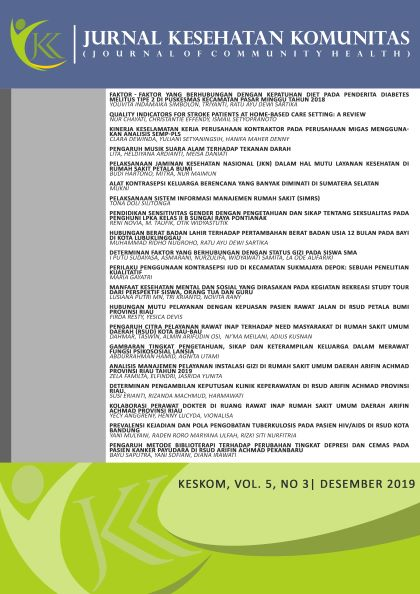QUALITY INDICATORS FOR STROKE PATIENTS AT HOME-BASED CARE SETTING: A REVIEW
home-based care quality indicators
DOI:
https://doi.org/10.25311/keskom.Vol5.Iss3.372Keywords:
home care, quality indicators, stroke, instrument validationAbstract
Background: One method to identify the level of performance is using quality of care indicators. Even though many quality indicators of health care have been announced, those which specify in home care services are limited in that none of them describe the stroke patients’ condition. The purposes of this study are to determine through systematic literature review what methods can be used to assess the quality of home care that patients received and to identify what components can be used as a determinant of the quality of home care services.
Method: Google Scholar, EBSCO, ProQuest and PubMed database websites were searched for articles and information.
Results: The method that was used is a qualitative study using a literature review with quantitative analysis of a previously accepted research instrument with a questionnaire that has been widely available and considered reliable. The researchers identified thematic differentiation in grouping the quality indicators used by those articles, however most of them are classified as outcome indicators, one as process indicator, and none as structure or input indicator. Overall quality indicators in home care that are used by the three articles are based on the Home Care Quality Indicators Instrument (HCQIs).
Conclusions: Several studies discussed home care quality indicators but no articles specifically analyze home care provision for stroke patients. Further research is needed to clarify the components indicators for stroke patients and more importantly, these indicators should be valid, and reliable.
Downloads
References
2. Ajlouni MT, Dawani H, Diab SM. Home Health Care (HHC) Managers Perceptions About Challenges and Obstacles that Hinder HHC Services in Jordan. Glob J Health Sci [Internet]. 2015;7(4):121–9. Available from: http://www.scopus.com/inward/record.url?eid=2-s2.0-84938934919&partnerID=tZOtx3y1
3. Sale D. Quality Assurance. 1996.1-143
4. Stalpers D, Kieft RAMM, Linden D Van Der, Kaljouw MJ, Schuurmans MJ. Concordance between nurse-reported quality of care and quality of care as publicly reported by nurse-sensitive indicators. BMC Health Serv Res [Internet]. BMC Health Services Research; 2016;1–8. Available from: http://dx.doi.org/10.1186/s12913-016-1372-z
5. Donabedian A. The quality of care. How can it be assessed? JAMA. 1988;260(12):1743–8.
6. Nakrem S. Understanding organizational and cultural premises for quality of care in nursing homes: an ethnographic study. BMC Health Serv Res [Internet]. BMC Health Services Research; 2015;15(1):508. Available from: http://www.biomedcentral.com/1472-6963/15/508
7. Bos JT, Frijters DHM, Wagner C, Carpenter GI, Finne-Soveri H, Topinkova E, et al. Variations in quality of Home Care between sites across Europe, as measured by Home Care Quality Indicators. Aging Clin Exp Res [Internet]. 2007;19(4):323–9. Available from: http://www.ncbi.nlm.nih.gov/pubmed/17726364
8. Mainz J. Developing evidence-based clinical indicators: a state of the art methods primer. Int J Qual Health Care. 2003;15(1):i5–11.
9. Hirdes JP, Fries BE, Morris JN, Ikegami N, Zimmerman D, Dalby DM, et al. Home care quality indicators (HCQIs) based on the MDS-HC. Gerontologist. 2004;44(5):665–79.
10. Foebel AD, van Hout HP, van der Roest HG, Topinkova E, Garms-Homolova V, Frijters D, et al. Quality of care in European home care programs using the second generation interRAI Home Care Quality Indicators (HCQIs). BMC Geriatr [Internet]. BMC Geriatrics; 2015;15(1):148. Available from: http://www.biomedcentral.com/1471-2318/15/148
11. Mofina AM. A Comparison of Home care Quality Indicators and The Influence of Risk Adjustment Between Two Provinces. 2010.
12. Klazinga N, Stronks K, Delnoij D, Verhoeff A. Indicators without a cause. Reflections on the development and use of indicators in health care from a public health perspective. Int J Qual Health Care. 2001;13(6):433–8.
13. Althabe F, Bergel E, Cafferata ML, Gibbons L, Ciapponi A, Aleman A, et al. Strategies for Improving The Quality of Health Care in Maternal and Child Health in Low and Middle Income Countries: Overview of Systtematic Review. Paediatr Perinat Epidemiol. 2008;22(1):42–60.
14. Firbank OE. Connecting the voices of users , caregivers and providers on service quality. Int J Health Care Qual Assur. 2012;25(5):403–20.
15. Parson J, Rouse P, Robinson EM, Sheridan N, Caonnolly MJ. Goal setting as a feature of homecare services for older people : does it make a difference ? Age Ageing. 2012;41:24–9.
16. Parsons JG, Parsons MJ. The effect of a designated tool on person-centred goal identification and service planning among older people receiving homecare in New Zealand. Heal Soc Care Community. 2012;20(6):653–62.
17. Gethin-Jones S. Familial perceptions of the impact of outcome-focused homecare with older people experiencing dementia and living alone. Emerald Gr Publ. 2014;18(2):90–6.
18. Goldman RE, Parker DR, Walker J, Eaton CB, Borkan JM. Recommendations for a Mixed Methods Approach to Evaluating the Patient-Centered Medical Home. Ann Fam Med. 2015;13(2):168–75.
19. Baumann M, Bihan E Le, Chau N. Associations between quality of life and socioeconomic factors , functional impairments and dissatisfaction with received information and home- care services among survivors living at home two years after stroke onset. BMC Neurol. 2014;14(92):1–25.
20. Andrea C, Castillo M. The Needs of Older People with Dementia Living at Home. University College London; 2008.
21. Wai W, Sun L. A Mixed Methods Study : Examining the Relationship between Therapeutic Self-Care and Adverse Events for Home Care Clients in Ontario , Canada. 2014.
22. Tarride J, Burke N, Leslie WD, Morin SN, Adachi JD, Papaioannou A, et al. Loss of health related quality of life following low-trauma fractures in the elderly. BMC Geriatr [Internet]. BMC Geriatrics; 2016;1–11. Available from: http://dx.doi.org/10.1186/s12877-016-0259-5
Downloads
Submitted
Accepted
Published
How to Cite
Issue
Section
License
Copyright @2017. This is an open-access article distributed under the terms of the Creative Commons Attribution-NonCommercial-ShareAlike 4.0 International License (http://creativecommons.org/licenses/by-nc-sa/4.0/) which permits unrestricted non-commercial used, distribution and reproduction in any medium












































